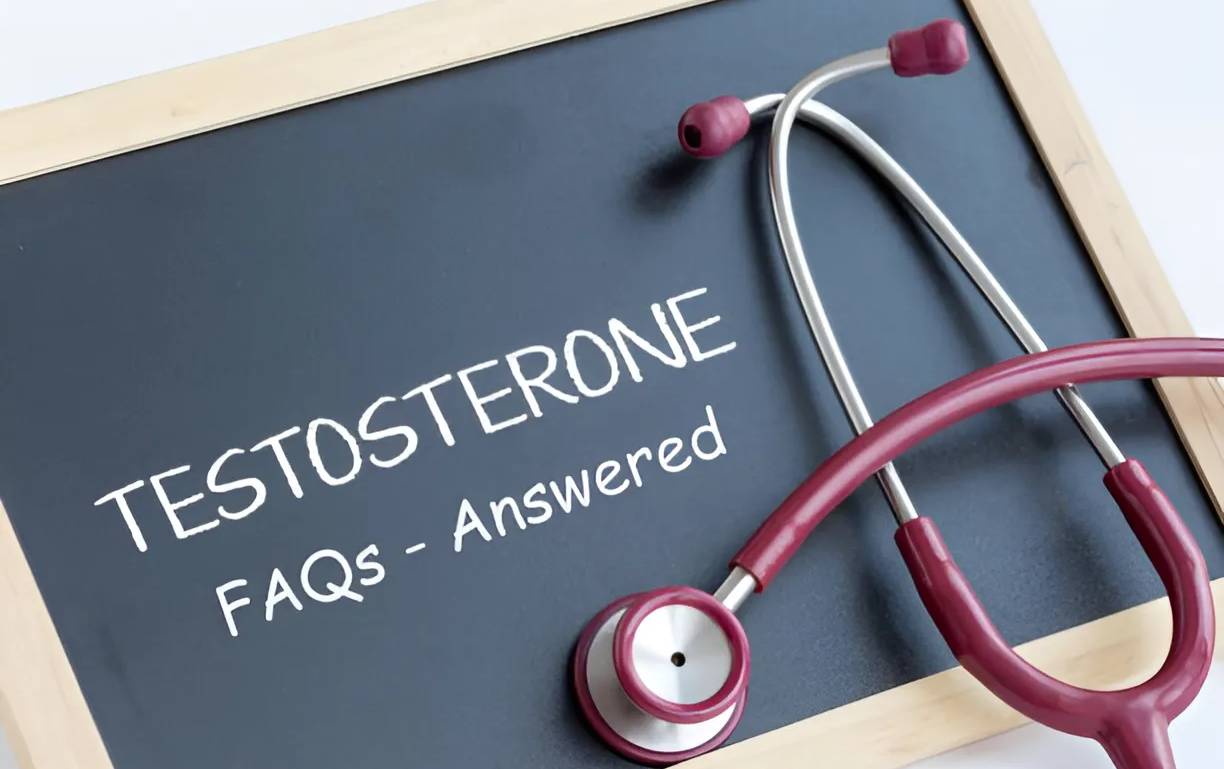Testosterone, the quintessential male hormone, is often shrouded in misconceptions and myths. From its role in the body to its impact on health and well-being, there’s a lot of confusion surrounding this vital hormone. In this comprehensive guide, we’ll separate fact from fiction and address some of the most frequently asked questions about testosterone, arming you with the knowledge you need to make informed decisions about your health.
What is Testosterone?
Before we dive into the myths and FAQs surrounding testosterone, let’s first understand what this hormone actually is. Testosterone is a steroid hormone primarily produced in the testicles of males and, to a lesser extent, in the ovaries of females. It belongs to a class of hormones known as androgens, which are responsible for the development and maintenance of male characteristics and reproductive function.
In men, testosterone plays a pivotal role in sexual development, physical characteristics like muscle growth and facial hair, and overall health and well-being, including mood, energy levels, and cognitive function. While predominantly associated with male traits, testosterone is also present in women, contributing to bone strength, fertility, and libido.
Testosterone levels fluctuate throughout a person’s lifespan, with peak levels occurring during late adolescence and early adulthood. As men age, testosterone production gradually declines, which can lead to various physical, emotional, and sexual changes if levels drop too low.
Common FAQs About Testosterone

What Does Testosterone Do?
Testosterone plays a crucial role in male sexual and reproductive development, influencing libido, sperm production, and erectile function. However, its effects extend far beyond just sexual health. Testosterone is vital for building and maintaining muscle mass, bone density, and strength. It contributes to the development of male characteristics during puberty, such as a deeper voice, increased body hair, and facial hair growth. Additionally, testosterone influences energy levels, mood, cognitive abilities, and red blood cell production, supporting overall vitality and mental sharpness.
How to Test Testosterone Levels?
If symptoms of low testosterone are present, a simple blood test called a serum testosterone test can accurately measure the amount of testosterone circulating in the bloodstream. It is essential to have the blood drawn in the morning before 10 AM, as testosterone levels follow a diurnal pattern, peaking in the morning and declining throughout the day. Additional tests like free testosterone or bioavailable testosterone levels may also be ordered by the doctor for a comprehensive evaluation.
What Foods Increase Testosterone?
Certain foods and nutrients are linked to boosting testosterone levels naturally. Fatty fish like tuna, salmon, and mackerel are rich in vitamin D, which plays a role in testosterone production. Eggs are a good source of cholesterol, a precursor to testosterone synthesis. Leafy green vegetables provide magnesium and zinc, both essential for optimal testosterone levels. Nuts and seeds offer healthy fats and minerals like zinc that support testosterone. Herbs and spices like ginger, ashwagandha, and fenugreek have traditionally been used to enhance testosterone and male fertility. A balanced diet with adequate protein, healthy fats, and micronutrients can help maintain optimal testosterone.

Where Is Testosterone Produced?
In men, testosterone is primarily produced in the testicles, specifically by specialized cells called Leydig cells. The hypothalamus and pituitary gland in the brain regulate testosterone production by signaling the testicles through the release of luteinizing hormone (LH) and follicle-stimulating hormone (FSH). Small amounts of testosterone are also produced by the adrenal glands, located on top of the kidneys. In women, the ovaries and adrenal glands are responsible for producing the small quantities of testosterone present in the female body.
What Foods Kill Testosterone?
Several foods and substances may have a negative impact on testosterone levels. Soy products contain isoflavones that can mimic estrogen activity and potentially lower testosterone. Refined carbohydrates, sugar, and unhealthy fats like trans fats promote insulin resistance, obesity, and potentially lower testosterone. Excessive alcohol consumption can impair testosterone production and disrupt hormone balance. Certain medications, such as opioid painkillers, glucocorticoids, and some antidepressants, can interfere with testosterone synthesis or activity. Maintaining a balanced diet rich in whole, unprocessed foods while limiting these testosterone-depleting culprits can help optimize hormone levels.
What Does Testosterone Do for Women?
In women, testosterone plays important roles in maintaining bone density and strength, preventing osteoporosis and fractures. It also contributes to a healthy libido and sexual arousal. Testosterone supports muscle development and maintenance, especially during and after menopause. It influences body composition, affecting fat distribution and helping to prevent abdominal obesity. Additionally, testosterone can impact mood, motivation, and mental sharpness by influencing neurotransmitter activity. However, excessively high testosterone levels in women can lead to issues like irregular periods, infertility, and increased body hair growth.

Where to Buy Testosterone Online?
It is crucial to understand that testosterone is a controlled substance and can only be legally obtained with a valid prescription from a licensed healthcare provider. Purchasing testosterone or other anabolic steroids online without a prescription is illegal and potentially dangerous. Online sources claiming to sell these substances without proper medical oversight may be selling counterfeit, contaminated, or improperly dosed products, posing severe health risks. If you have a legitimate medical need for testosterone therapy, consult with a qualified healthcare professional for a legal prescription.
What Causes Low Testosterone?
Several factors can contribute to low testosterone levels in men, including age (natural decline as men get older), obesity (excess body fat disrupts testosterone synthesis), chronic health conditions like diabetes, kidney disease, and HIV/AIDS, injury or infection to the testicles, certain medications like opioids and chemotherapy, and lifestyle factors such as poor diet, lack of exercise, excessive alcohol consumption, and chronic stress. In some cases, genetic or congenital conditions like Klinefelter syndrome or pituitary gland disorders may also be the underlying cause.
What Causes Low Testosterone in Young Males?
While low testosterone is more commonly associated with aging, it can also occur in younger men due to various factors. Klinefelter syndrome, a genetic condition where males are born with an extra X chromosome, can affect testosterone production and fertility. Pituitary gland disorders, such as tumors, can disrupt the hormonal signals that regulate testosterone synthesis. Testicular injuries, infections like mumps orchitis, excessive alcohol or drug use (particularly anabolic steroid misuse), obesity or underlying health conditions like diabetes, and radiation or chemotherapy treatment for cancer can all contribute to low testosterone levels in young males.

How to Know If You Have Low Testosterone?
Several signs and symptoms may indicate low testosterone levels in men, including decreased sex drive (low libido), erectile dysfunction or difficulty achieving/maintaining an erection, fatigue and low energy levels, loss of muscle mass and strength, increased body fat and weight gain, mood changes like irritability or depression, reduced bone density, and decreased body hair growth. If multiple symptoms are present, it is advisable to consult a healthcare professional for evaluation and potential testosterone level testing.
How to Lower Testosterone?
In most cases, there is no need to lower testosterone levels unless they are abnormally high due to conditions like congenital adrenal hyperplasia or tumors. However, certain medications like androgen deprivation therapy may be used to lower testosterone levels in cases of prostate cancer treatment. For men with normal or low testosterone, lowering levels is generally not recommended, as it can lead to various negative effects on physical and sexual health.
How to Lower Testosterone in Women?
In women, high testosterone levels can cause issues like irregular periods, excessive facial and body hair growth (hirsutism), and fertility problems. Treatment options may include birth control pills or other hormone therapies to suppress testosterone production. Anti-androgen medications that block the effects of testosterone may also be prescribed. In severe cases, surgery to remove the source of excess testosterone production (such as a tumor) may be considered.
What is a Dangerously Low Testosterone Level?
While testosterone levels can vary widely among individuals, most healthcare providers consider a total testosterone level below 300 ng/dL (nanograms per deciliter) to be low. However, dangerously low levels below 150 ng/dL can lead to more severe symptoms and increase the risk of health complications like osteoporosis, anemia, and cardiovascular issues. If testosterone levels drop significantly below normal ranges, it is crucial to identify and address the underlying cause with proper medical treatment.

What Are the Side Effects of a Female Taking Testosterone?
When women take testosterone supplements or engage in testosterone therapy, potential side effects may include male-pattern baldness, excessive body hair growth (hirsutism), acne, deepening of the voice, irregular menstrual periods, and, in some cases, fertility issues. Higher doses or prolonged use of testosterone can also increase the risk of heart disease, liver problems, and other health complications in women. It is essential to follow medical guidance and carefully monitor any testosterone treatment in females.
How Much Ashwagandha Per Day for Testosterone?
Ashwagandha, an adaptogenic herb used in Ayurvedic medicine, has been studied for its potential to boost testosterone levels in men. While dosages can vary, most studies have used between 300-600 mg of ashwagandha root extract per day, divided into two or three doses. However, it is essential to consult with a healthcare professional before taking any supplements, as they may interact with medications or have adverse effects in certain individuals.
How to Treat High Testosterone in a Woman Naturally?
For women with high testosterone levels, natural treatment options may include lifestyle changes such as weight loss (if overweight or obese), stress management techniques like meditation or yoga, and regular exercise. Additionally, certain herbs and supplements like saw palmetto, spearmint tea, and licorice root have been traditionally used to help balance hormone levels, although more research is needed on their effectiveness. If natural approaches are ineffective, medical treatment may be necessary to address the underlying cause of excess testosterone.

What is the Normal Level of Testosterone in a Woman?
In women, normal testosterone levels can range from 15 to 70 ng/dL (nanograms per deciliter), depending on age and other factors. However, levels above 70 ng/dL may be considered high and can potentially lead to symptoms like irregular periods, infertility, and increased facial and body hair growth (hirsutism). Testosterone levels in women tend to be highest during reproductive years and gradually decline with age, especially after menopause. It’s essential to maintain a healthy balance, as both excessively high or low testosterone can have adverse effects on a woman’s overall health and well-being.
Myths About Testosterone
#Myth 1: Testosterone is only important for men. Fact: While testosterone is often associated with male characteristics, it plays crucial roles in women’s health as well, including maintaining bone density, libido, and muscle strength.
#Myth 2: Testosterone supplements are safe and legal to buy online. Fact: Purchasing testosterone or other anabolic steroids online without a prescription is illegal and can be extremely dangerous, as these products may be counterfeit or contaminated.
#Myth 3: High testosterone levels in men are always better. Fact: While low testosterone can be problematic, excessively high levels can also lead to issues like prostate problems, sleep apnea, and an increased risk of heart disease and stroke.
#Myth 4: Testosterone causes aggressive behavior and “roid rage.” Fact: While high doses of synthetic testosterone may potentially increase aggression in some individuals, normal physiological levels of testosterone are not directly linked to aggressive or violent behavior.
#Myth 5: Testosterone therapy is a “fountain of youth” for older men. Fact: While testosterone replacement therapy can help alleviate some symptoms of low testosterone in older men, it’s not a cure-all or a way to reverse the aging process. It should be carefully considered and monitored by a healthcare professional.
In Summary
Testosterone is a complex and multifaceted hormone that plays a vital role in various aspects of human health and well-being. By understanding the facts and dispelling common myths, you can make informed decisions about maintaining healthy testosterone levels and optimizing your overall wellness. Remember, if you have any concerns about your testosterone levels or hormonal health, it’s always best to consult with a qualified healthcare professional.


